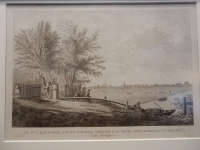
Engraving of T. de Roode and M. Roelofsvaert, ca 1780.
| For the photo's, see below |
| Home / the complete website |
|
The governors of the General Orphanage in Den Burg let out the water right of the Wezenputten to the amount of:
|

|
|
"The well that supplies water to the ships, on Texel, 't Schild [Oudeschild wds] in a distance". Engraving of T. de Roode and M. Roelofsvaert, ca 1780. |
| A medium-sized merchant ship with a capacity of 360 ton (180 'lasten') had a crew of about 300 people on board and took with them 170 'leggers' and 27 'varkens' (563 resp. 281 liters) which represent 103.300 liters / 103 m3 / 103 ton (!) fresh water. |
| Recommended literature : |
|
| Recommended websites : |
|
| How to visit : | see above |
| HOME | More literature on more aqueducts | Last modified: April, 2018 - (webmaster) |